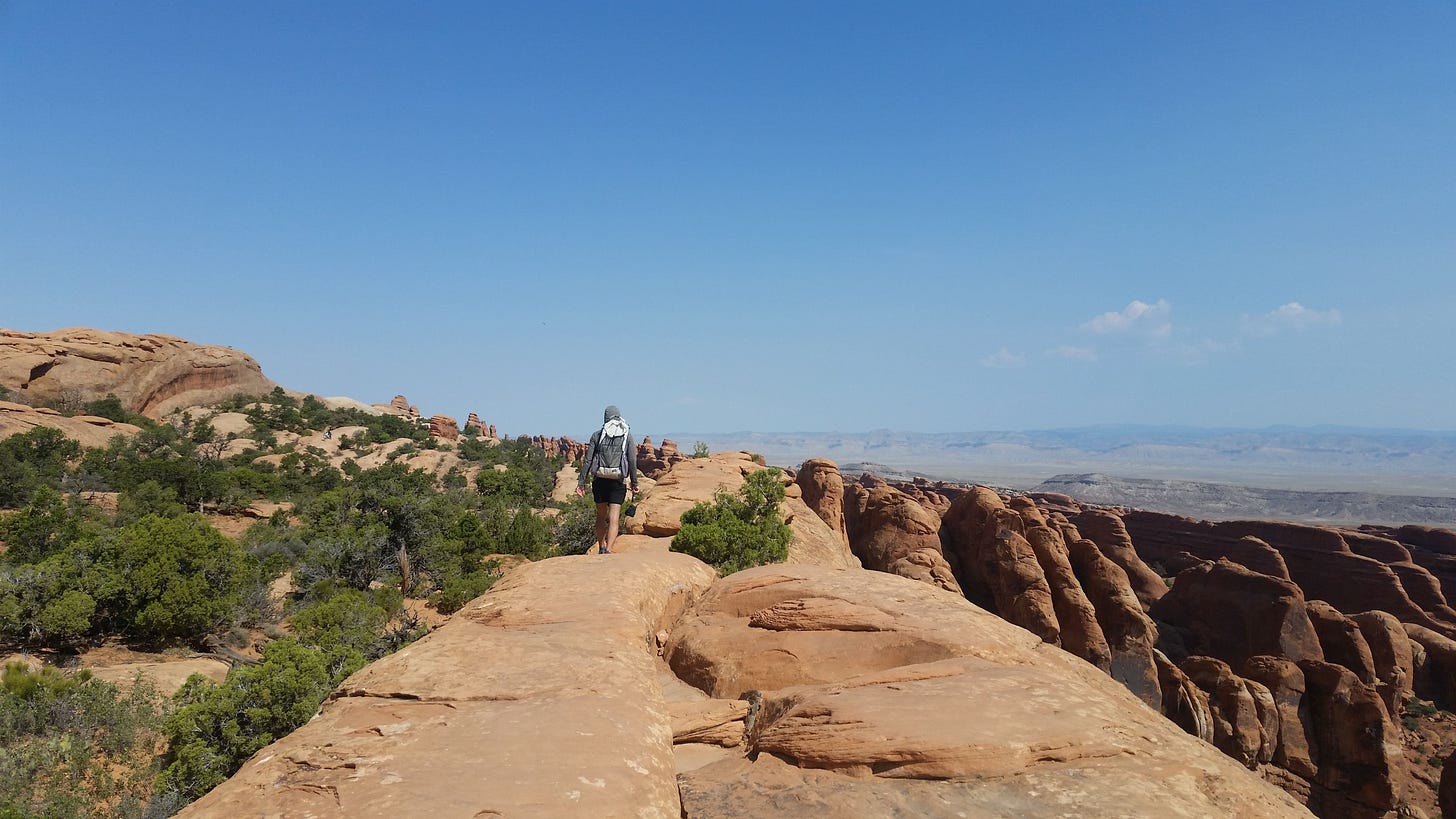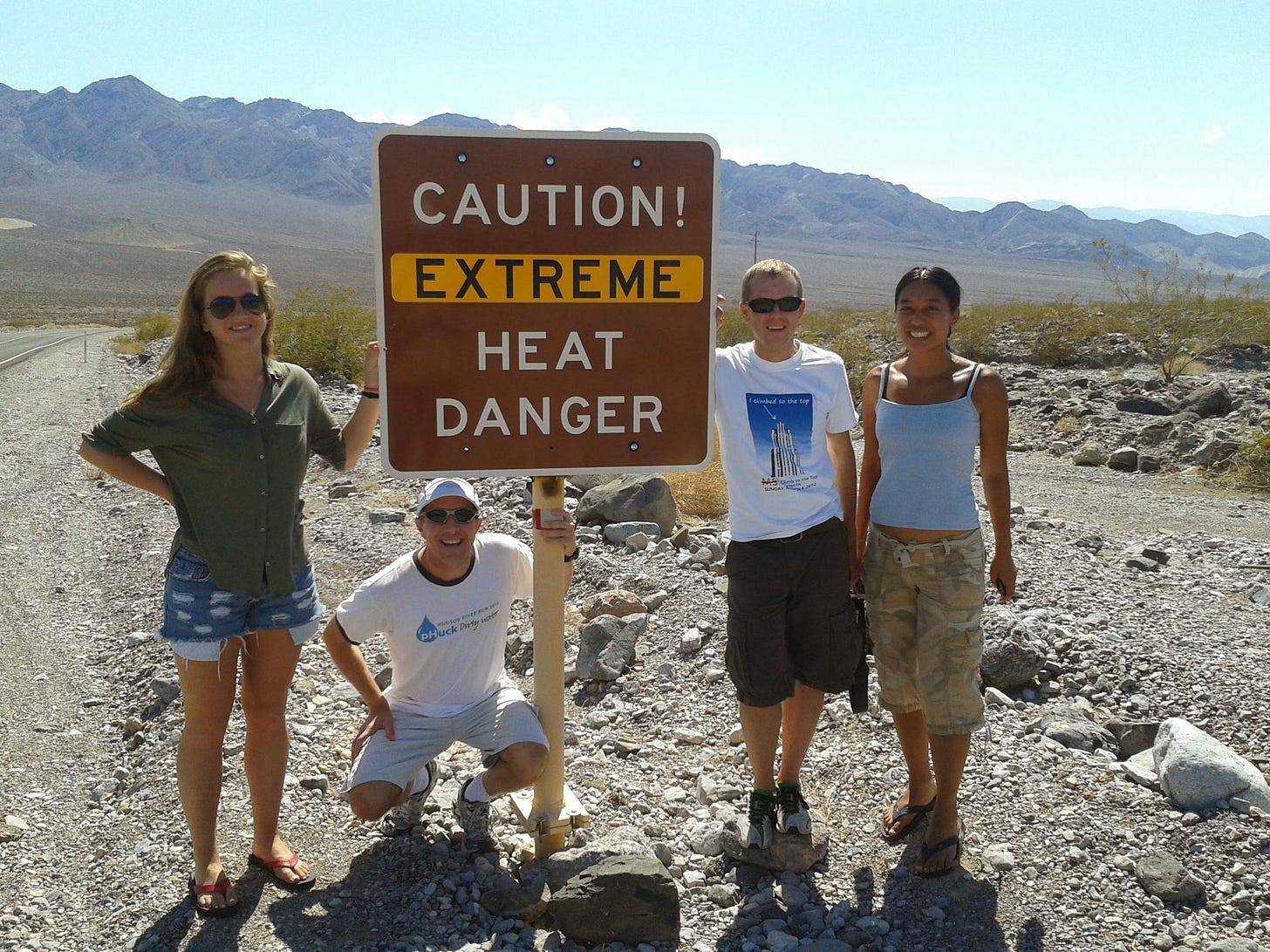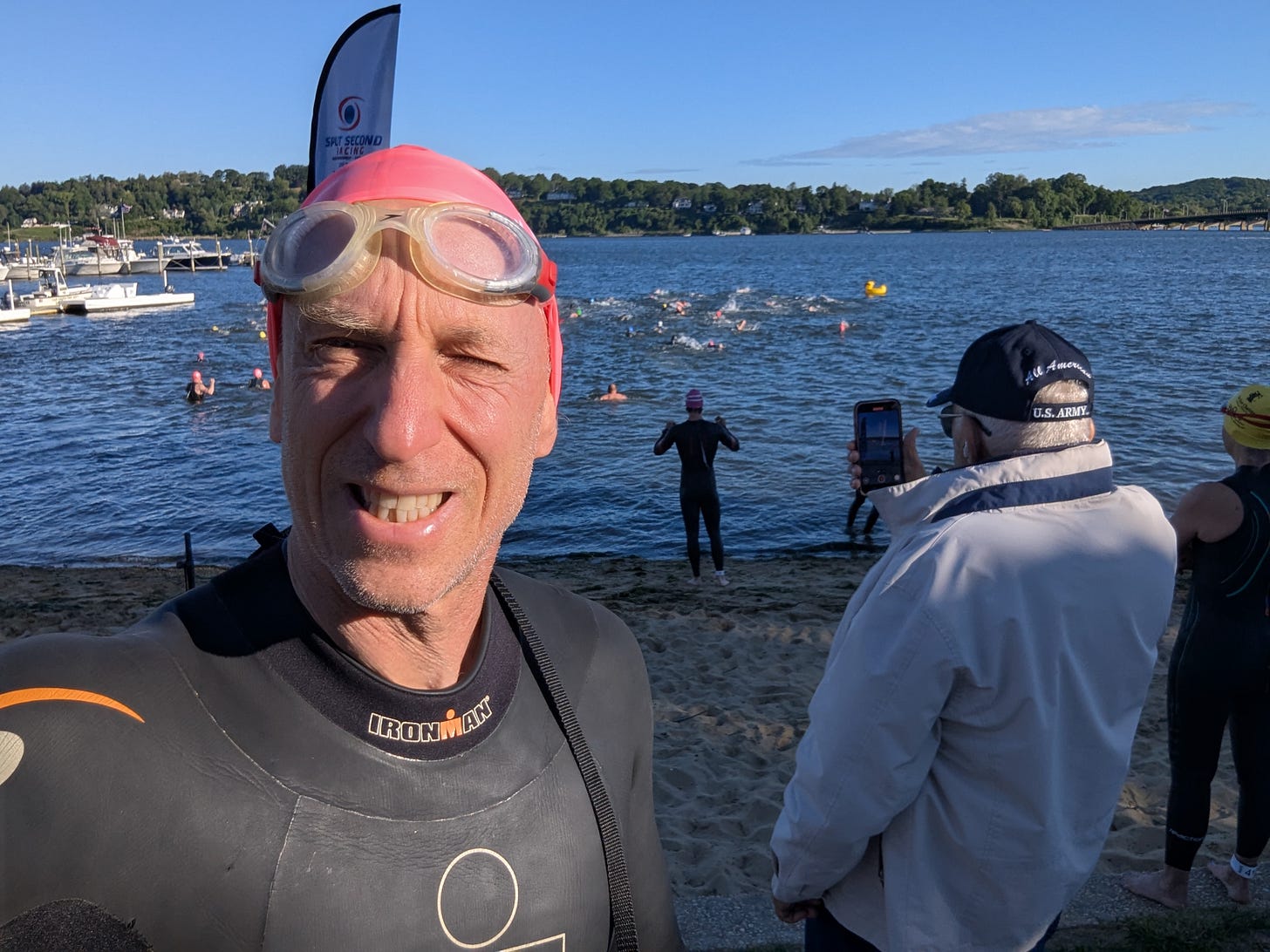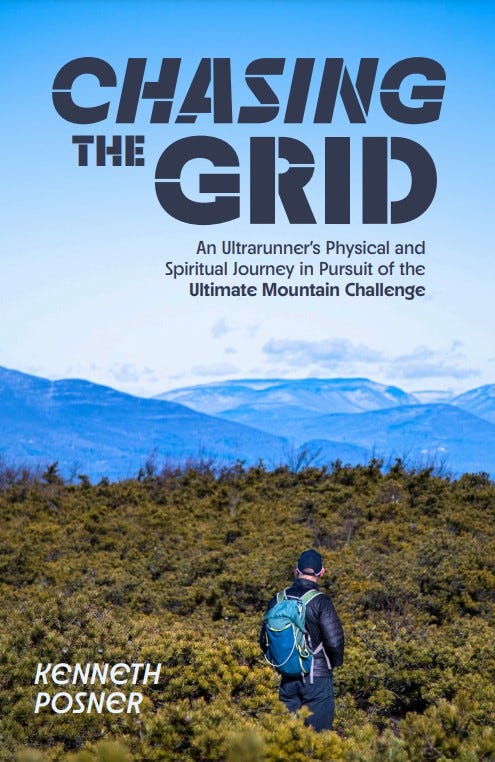The Memorial Day weekend was off to a good start, for the most part. Following a 4-hour drive to Vermont, I woke up the next morning and coughed up some phlegm, the tail effect of a chest cold the week before. Got dressed, walked toward the starting line, felt a back spasm, probably the result of sitting in the Jeep for so long the day before. A couple of Ibuprofen left me a little looser, and feeling excited if unsure, I headed out on the Infinitus 9-mile trail race with some gusto. Although a tight hamstring, the result of an injury the month before, limited my speed on the uphills. While a sea of mud limited my speed on the downhills. The last mile was relatively clear, and here finally I ran hard, and after receiving a large finisher’s medal and a handshake from the organizer, Andy Weinberg, I limped back to the Jeep for an even longer drive: 6 hours to New Jersey, where the next day I was going to take on a 1.6-mile open water swim in the Navesink River.
Back in my triathlon days (some twenty years ago), I completed a number of open-water swims. More recently, I’d been practicing in the pool, working on both distance and speed, and feeling pretty good – although it was nice to stop and stand in the shallow end to clear the fog from my goggles and catch my breath after a hard lap or two – a luxury that would be unavailable in the Navesink.
I survived the drive to New Jersey without my lower back feeling any worse and was out of bed early the next morning, pulling in first to a Dunkin Donuts, where I had my morning espresso – and then, still feeling sluggish, a second one – and fifteen minutes later arrived at a small park on the bank of the Navesink. With 15 minutes until start time, I pulled on my wetsuit, which I’d tested it in the swimming pool a few days earlier, just to make sure after 20 years it was still functional. With 5 minutes to go, I stepped into the water and found, to my surprise, that it was a sandy brown color. Quite brackish. And cold. The front crawl requires you to place your face directly in the water, but that felt unappealing. Instead, when the horn sounded, I started out in breast stroke mode, keeping my head well out of the water, while trying to follow the pack of swimmers out into the dark, cold, deep water.
Let’s talk about risk management in high-stakes situations. Let’s talk about black holes. And panic.
Black Holes
The first principal of risk management – the best course of action regarding serious risks is to avoid them in the first place. This principal is paramount for black holes, because if you were to land your spaceship on the surface of one, you’d be crushed into subatomic particles instantly. Actually, your fate would be sealed before then. The “Event Horizon” is the distance from a black hole’s center beyond which nothing can escape its gravitational pull, not even light. For a typical stellar-mass black hole (created in the collapse of a star), the Event Horizon might be on the order of 30 kilometers distant from the black hole’s center. However, for a supermassive black hole, such as are found at the centers of galaxies, the Event Horizon might be more than 10 million kilometers away.
Actually, the line of fatal danger might lie even farther out. Depending on the size and rotational speed of the black hole, its gravitational tides might be powerful enough to shred your spacecraft to pieces even before you reached the Event Horizon. And then there’s the question – how maneuverable is your spacecraft? If you’re flying straight toward the danger zone, how much time do you have to turn the wheel (or push the joystick) before it’s too late to steer away?
For every kind of risk, we can conceptualize the probability of a bad outcome as a “distance” to that event. But as the black hole illustrates, these distances can be tricky to estimate. Certain kinds of risk factors may cause your speed to accelerate as you near a problem, setting the stage for even small misjudgments to pose catastrophic consequences.
As I breast-stroked out into the Navesink, I could see clearly and breathe with ease. But I wasn’t moving very quickly. And I wasn’t going to be able to sustain the breast-stroke for 1.6 miles, as I hadn’t practiced this stroke in the pool in several years. After a moment’s reflection, I concluded this strategy wasn’t realistic and turned back for the shore with a new plan in mind. I could try again with the next wave, scheduled to start in 10 minutes, giving me time to splash around and get more comfortable with performing the front crawl in this cold, brown, salty water. This new strategy seemed promising. After a few tentative attempts, I was able to grit my teeth and place my face down in the murky water and execute a few strokes, just like in the pool. Although in between each stroke, I rotated my head way out of the water – until my face was pointing straight up towards the sky, just to make sure I didn’t swallow anything accidentally (when you do the stroke properly, you’re supposed to rotate your face only slightly above the water).
Today, as I think back on the various adventures I’ve had the privilege to undertake and also to survive, it occurs to me that there are a variety of risks that are similar to those of black holes in terms of the potential for problems to accelerate as you get closer to the bad outcome.
Slippery Slopes
In the Catskill Mountains, the summits are typically capped in ledges. To admire the views, you can walk right up to the edge thanks to the secure footing provided by Devonian (375 million years old) graywacke sandstone with high quartz and silica content, which makes for durable surfaces resistant to weathering.
In contrast, I’ve hiked in Utah on fins and ridges composed of Navajo formation sandstone (nearly 200 million years old) compacted from vast seas of wind-whipped dunes. Here the ledges are rounded – they start off flat but then gradually roll off into space. Depending on the grip of your shoes (or feet), there is a point of no return, similar in concept to the black hole Event Horizon, where the pitch is steep enough for you to start sliding. Yet there’s another factor to consider – Navajo sandstone is “friable,” meaning the rocks deteriorate under weathering. As a result, you might find, as the slope gets steeper, that there are loose grains of sand underfoot. A sudden slip and fall could send you towards the point of no return more quickly than expected.
That never happened to me during my hikes, in part because I kept well clear from the rounded cliff edges and on some trails, feeling uncomfortable, I turned back early.
Extreme Heat
Back in the days when I ran the Badwater Ultramarathon in Death Valley, I trained in the sauna as well as on the roads to ensure my body was ready to deal with temperatures in the 120s F.
Now, people worry about dehydration, and to be sure, drinking a lot of water is part of how you stay safe in hot conditions. But while dehydration can make you miserable, it rarely kills. What typically happens is that as you become dehydrated, thirst, headache, cramps, and other symptoms cause you to move more slowly, helping to conserve what moisture you have left. Far more dangerous is heatstroke, which is when the body loses its ability to keep cool.
The way the body manages temperature when it’s hot, is to pump the blood close to the surface of the skin, where the heat from the hot liquid can radiate away, especially if there is sweat on the skin to evaporate. This is a very efficient cooling system, which differentiates us from most of our animal relatives who do not sweat but rely on panting to expel excess heat.
But here’s the catch – as core temperature rises, the body responds by pumping a bigger volume of blood to the surface. And at a faster rate. This takes more effort. If you’re not fit – meaning that a higher heart rate is stressful – or if you’re not acclimatized – meaning that your body’s not used to shunting blood toward the skin – the extra effort can generate incremental body heat. Which can precipitate an out-of-control escalation in core temperature and fatal crisis.
When I was running in the desert and the heat began to feel overwhelming, I slowed down. And never had a problem. I recall passing the Mesquite Dunes during the heat of late afternoon, plagued by a stiff headwind. Later I learned that a tourist had disembarked from a bus right there, wandered out into the dunes, and succumbed. I recall taking a hike in the canyons near Zabriskie Point, being careful to stray no more than one mile from my car. Later I learned that a movie actor with a role in the Harry Potter movies had perished from heatstroke in this area, just a few days earlier.
[caption id="attachment_58382" align="alignnone" width="660"]
User comments[/caption]
Panic
Panic is another kind of factor that can accelerate the speed to bad outcomes.
Typically panic starts in a high-risk situation when the body delivers an extra surge of energy to the brain. Energy to help you think your way out of whatever pickle you’ve gotten yourself into.
But if you can’t manage that surge of energy, it turns counterproductive. Mental processes get overwhelmed. Instead of figuring out what to do, you suffer from too many thoughts rushing around chaotically. The cognitive load becomes unmanageable.
The way you learn to deal with panic is through practice. Hopefully in situations where the stakes are high enough to focus your attention, but the risks not truly severe. Like running a race. Navigating in the forest. Climbing a cliff or in the gym. Participating in martials arts. Or combat training with live ammunition. Trading stocks in volatile markets. Dealing with irate bosses, spouses, strangers, friends. With experience, you get better at controlling your mind. As you accumulate domain expertise, the mental problems become more familiar and hence easier to solve.
As for me, when the horn went off for the second starting wave in the Navesink River swim, I splashed out into the dark, cold, salty water behind a group of swimmers, raised an arm overhead and dug in with a strong confident motion that propelled me forward. As I rotated my face out of the water for a gulp of air, I felt a tickle in my throat from that lingering head cold. Pictured myself out in the middle of the dark deep river coughing up phlegm. While trying to tread water. Which I hadn’t practiced doing in several years. Wondered what my mental state would be like in that situation. I took one more stroke, turned around, and splashed back to the shore.
I didn’t get a medal, but on a positive note I got to see some friends for brunch, and on the way home I stopped and climbed a small mountain. So it was definitely not a wasted day.






Great piece Ken! Glad you are doing well!
Terrific story and message. Look forward to the book. Also, I learned a new word today (Brackish).